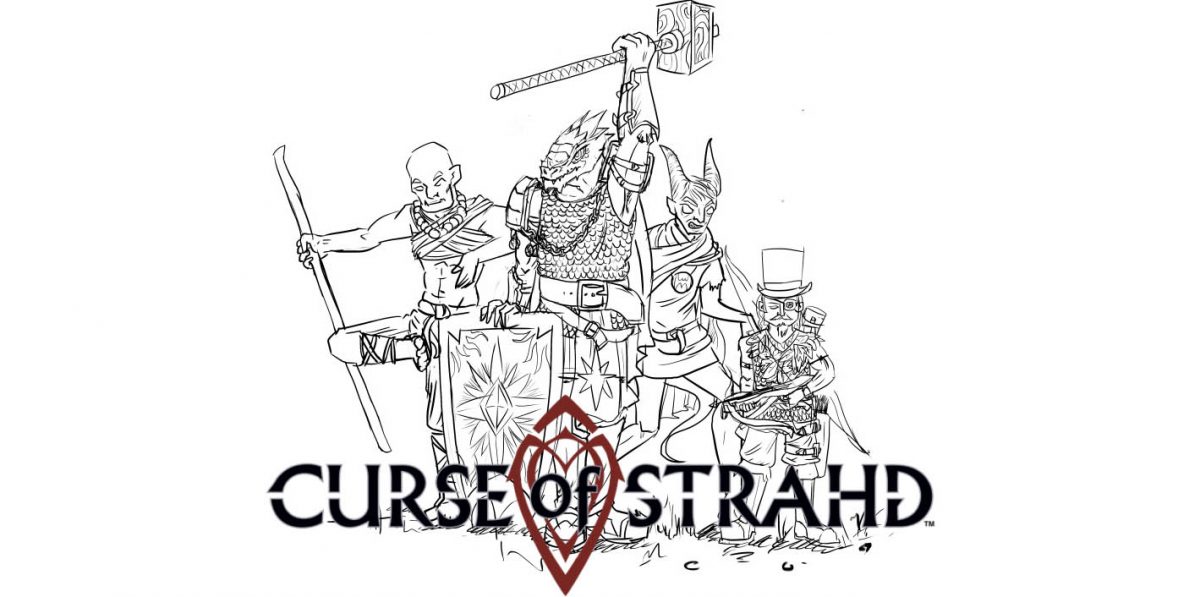The rainforest is a complex ecosystem with tall trees, lush undergrowth, and a variety of wildlife. In this compact card game, you’ll compete to grow the best Canopy.
In Reaping the Rewards, I take a look at the finished product from a crowdfunding campaign. Canopy was initially funded on Kickstarter in July 2020, and shipped to backers at the end of 2021. It’s now available in stores or directly from the publisher. This review is adapted from my Kickstarter Tabletop Alert, updated with finished components and rules.
What Is Canopy?
Canopy is a tableau-building game for 1 to 4 players, ages 8 and up, and takes about 30 minutes to play. It’s for $20 for the retail edition or $29 for a deluxe edition that includes a travel bag and wooden animal tokens, and is available in game stores or directly from the publisher.
Canopy was designed by Tim Eisner and published by Weird City games, with illustrations by Vincent Dutrait.

Canopy Components
Here’s what comes in the retail version:
- 5 Game Board cards (3 Standard, 2 Variants)
- 140 Rainforest cards (112 Standard, 28 Advanced)
- 21 Seed cards
- 4 Awards tokens (3 Tallest Tree, 1 Largest Forest)
- 11 Shifting Seasons cards
- 50 Point tokens (in denominations of 1, 5, 10 and 25)
- 10 Wildlife tokens
- 4 Starting Trunk cards
- 2 Player Aid cards
The rainforest cards and seed cards are half-sized cards. The advantage is that you’ll have a lot of these spread out as you build your tableaus, and full-sized cards would take up a significant amount of space. The disadvantage is that I find this small size to be a bit harder to shuffle well, especially with 112 (or 140!) cards that need to be shuffled into a single deck, though that’s my personal preference.
The “board” is made up of three tarot-sized cards, and it basically just indicates where you should keep certain cards. It’s almost not necessary once you know how to play the game, but it’s a convenient way to keep track of things.
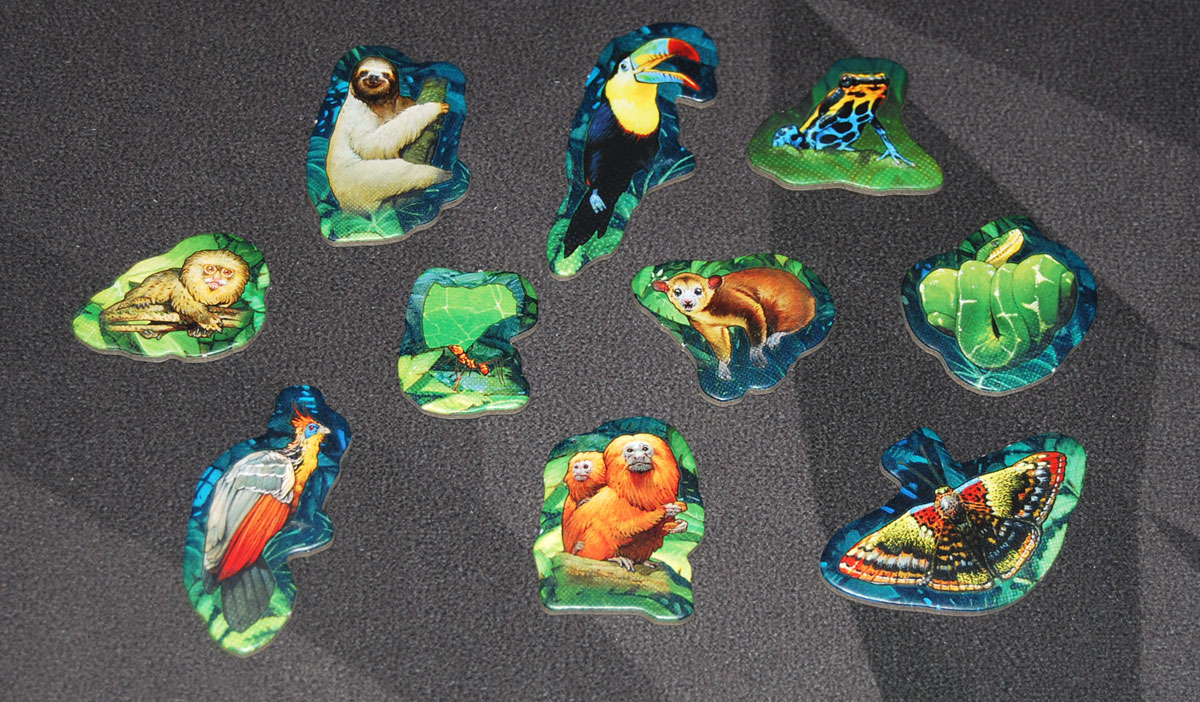
The animal tokens—cardboard in the retail edition and wooden in the deluxe edition—are used to mark a completed tree that has already been scored; while they match the wildlife shown on some of the cards, you don’t necessarily take a token that matches cards you have.
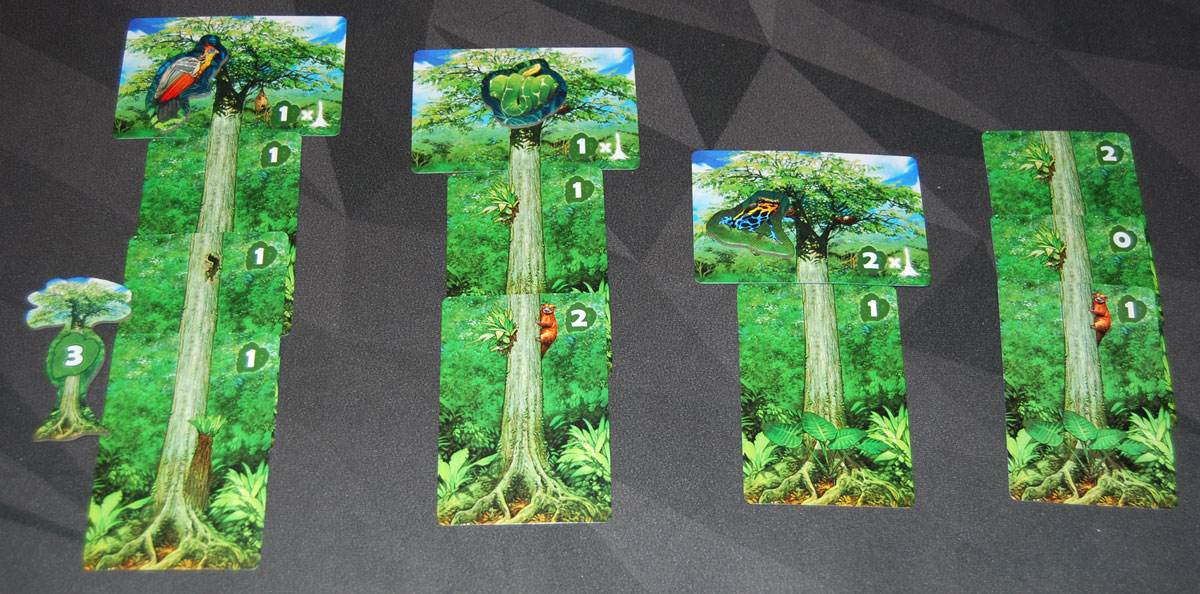
The illustrations for the game are by Vincent Dutrait, and I really love his artwork. Most games I’ve seen with his artwork tend to have people and human artifacts, so it was cool to see his take on a game that is entirely set in the natural world, with no human presence at all. One of the fun touches in the game is that the tree trunk cards stack up to make tall trees, topped off by a canopy card.

As a side note, Weird City Games also made a 1000-piece jigsaw puzzle of the cover artwork and provided a sample to me. It was definitely a challenge to assemble given the large sections of blue and the areas of foliage, but it was also really great to see Dutrait’s artwork at a larger scale.

Weird City Games wanted Canopy to be as environmentally conscious as possible, using a compact box and eliminating plastic from the game. There are some small paper envelopes included to store tokens, and the box uses a simple cardboard divider to keep the cards organized. (They also experimented with brown paper wrapping instead of plastic shrink wrap, which was fine for the Kickstarter backers but was less popular with retail stores.)
How to Play Canopy
You can download a copy of the rulebook here.
The Goal
The goal of the game is to score the most points over 3 seasons of growth, with a combination of trees, smaller plants, and animals.
Note that the rules are primarily written for a 2-player game, with variants for solo play or 3-/4-player play. I’ll start with the 2-player rules here, and then explain the differences afterward.
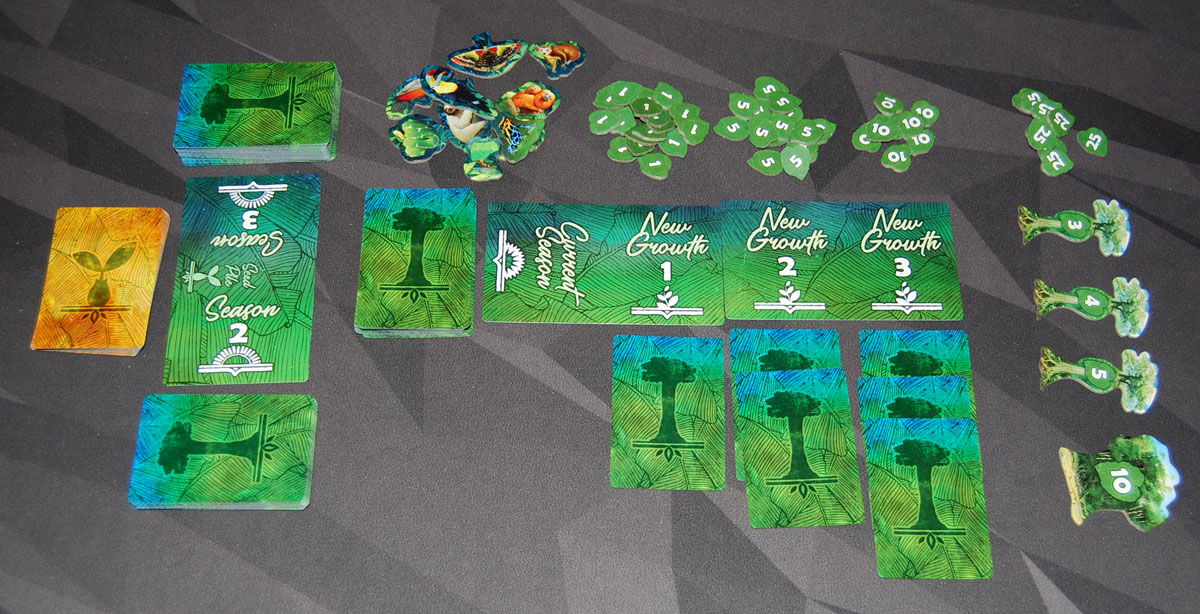
Setup
Lay out the game board cards. Shuffle the rainforest cards and return 10 cards to the box without looking at them. Divide the rest of the deck into 3 equal piles, placing one each in “Current Season,” “Season 2,” and “Season 3.” Shuffle the seed cards and place them next to the board in the “Seed Pile” area. Place the point tokens, awards tokens, and wildlife tokens nearby.
Draw cards from the Current Season deck and place 1, 2, and 3 cards in the New Growth 1, 2, and 3 areas, respectively.
Give each player a starting trunk card. The player who most recently watered a plant goes first.
Gameplay
On your turn, you will select cards to add to your rainforest from the New Growth areas. Starting with New Growth 1, you may look at all the cards in that pile, and then decide whether to take them or pass. If you pass, add 1 card face-down from the Current Season deck to the pile and then move to the next pile. If you take a pile, place all of the cards from that pile face-up in your rainforest tableau in front of you, and then refill that pile with 1 card from the Current Season deck. If you pass on all 3 piles, then you take 1 card from the Current Season deck.
Note that you may not go back to an earlier pile once you’ve passed it, and you only take from one pile (or the top of the Current Season deck) per turn.

Cards you collect are simply placed face-up in front of you, grouped by type. When you collect tree cards, you can place trunk cards either to start new trees, or to grow existing trees that don’t have canopies yet. If you take a canopy card, you must place it on an incomplete tree, unless you don’t have any, in which case it is discarded. (You can’t save canopy cards for later.)
Drought cards are a special threat card: as soon as you place one in your tableau, you must immediately discard another card from your rainforest.
Season End
When the deck runs out, players continue until all of the New Growth piles are empty, and then the season ends. Then you follow these steps, collecting point tokens as needed:
- Seeds
- Fire and Disease
- Trees
- Plants and Weather
- Cleanup
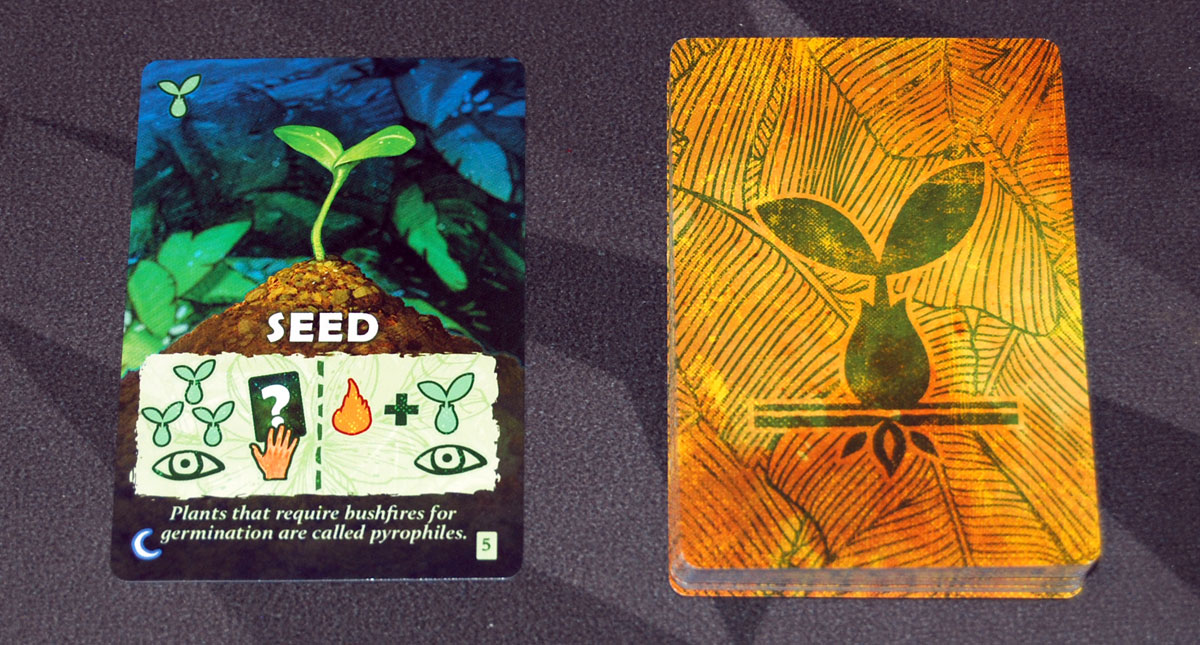
Seeds: If you have any seeds, you get to draw 3 cards from the special Seed deck plus 1 for each Fire card in your Rainforest. You may keep 1 card for each seed in your forest, discarding the rest. Then discard the seeds. The Seed deck includes various plants and trees, as well as some weather cards.

Fire and Disease: If you have 2 Fire cards, you must discard 2 plant cards (not trees) from your forest. If you have 3 or more Fire cards, it spreads and you lose 1 plant and your opponent loses 1 plant. Disease functions in the same way, but affects wildlife cards.
Trees: Score your completed trees that have not been scored already in previous seasons. Each trunk card is worth its printed value; the canopy card is worth a certain number of points per trunk card in that tree. Also, the player with the tallest tree completed this season earns a bonus award: 3 points in the first season, 4 points in the second season, and 5 points in the third season. (If there’s a tie for tallest tree, both players earn the points for that award.)

Plants and Weather: Score points for your plants and weather. Plants score points based on how many you’ve collected. Each set of 3 Philodendrons is worth 8 points; Bromelias are worth points for 1 or 2 of them, but cost you points if you have more; Ferns score 2 points per card if you have an odd number of them, but score nothing if you have an even number.
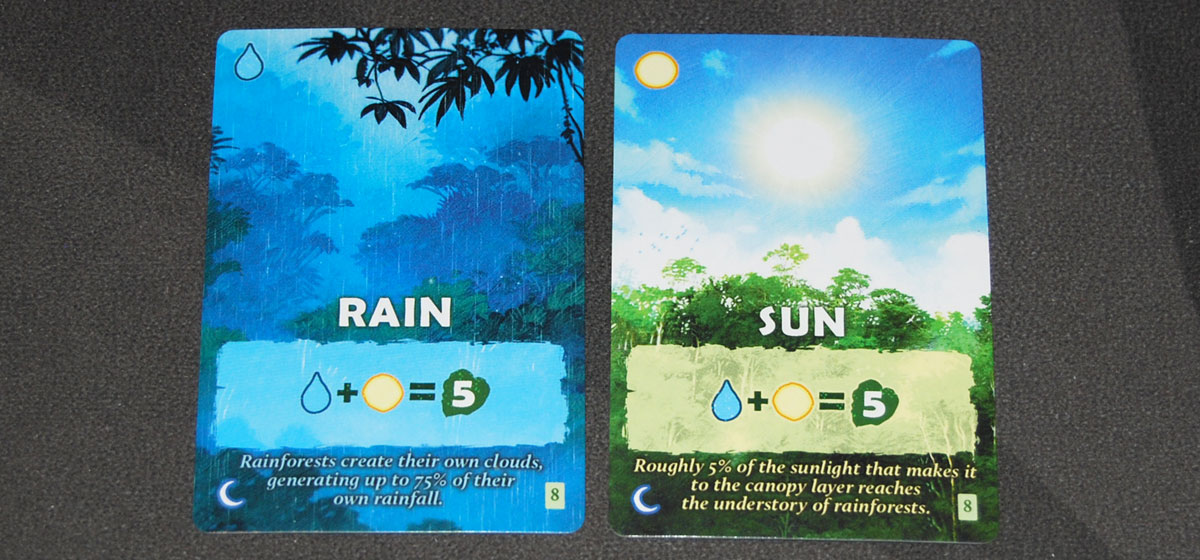
Each set of Sun and Rain cards will score 5 points.
Cleanup: Discard everything except wildlife, which will only score at the end of the game, and trees. Then put the next season’s stack of cards into the Current Season area, and start the New Growth piles as before. The player who did not earn the tallest tree award goes first.
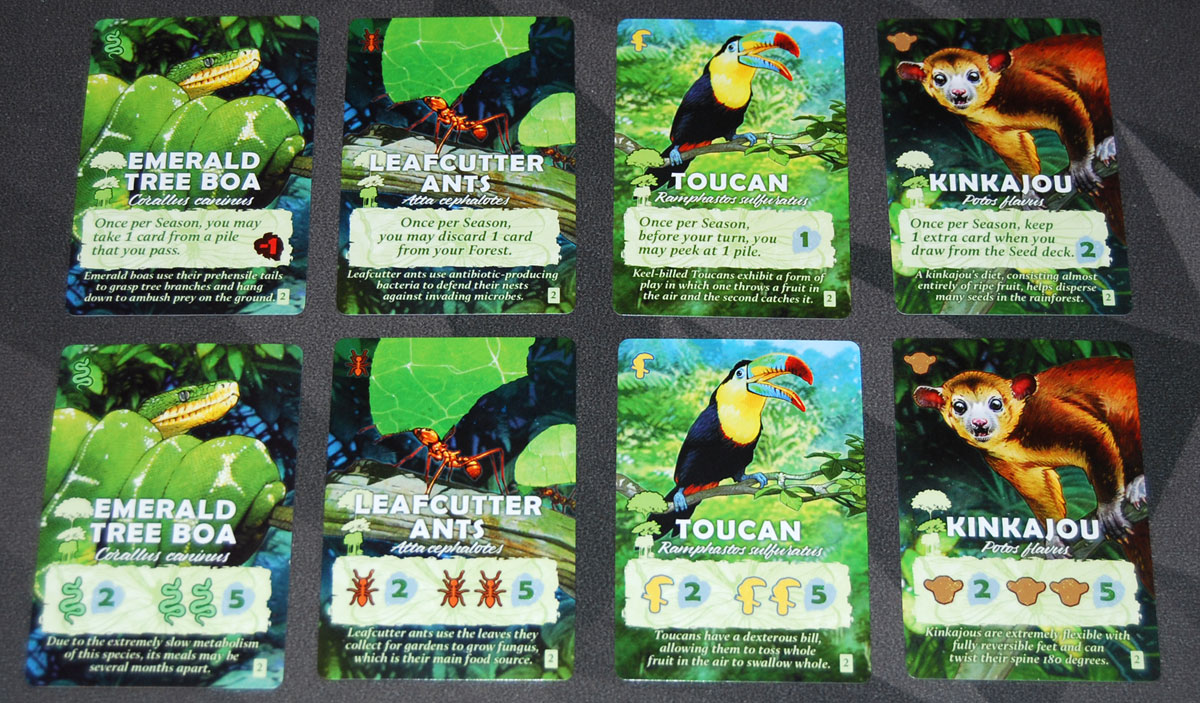
Game End
The game ends at the end of the third season. Score the season as usual, but then also score for the wildlife. Each animal in the game has two cards: one of them has an ability on it that can be used once per season, and the other is worth points based on whether you have one or both of that animal.
Also, whoever has the most completed trees gains the Largest Forest bonus (worth 10 points). If there’s a tie, the player with the most incomplete tree sections gets the bonus.
The player with the highest score wins, with ties going to the player with the most wildlife.
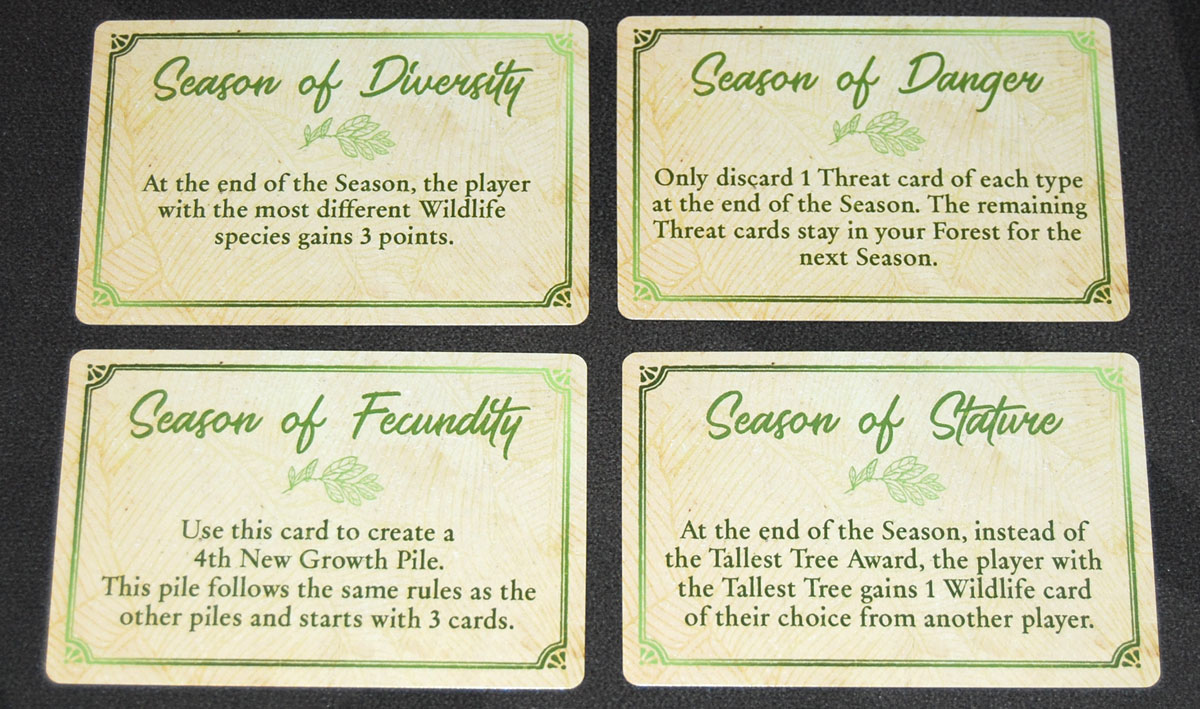
Shifting Seasons
The Shifting Seasons mini-expansion adds a new wrinkle: each round, you draw a random Shifting Seasons card, which has a rule that will apply for that particular round. For instance, you might get 1 point per plant at the end of the season (in addition to the regular scoring for plants), or you might have to discard incomplete tree sections from your forest but score points for them.
Solo Rules
For a solo game, you’ll play against an automated opponent called the Forest Spirit. You take your turn as usual, but any threat cards you pass are returned face-up instead of face-down.
The Forest Spirit has rules that explain which pile it will take—the most cards, the fewest face-up cards, the left-most pile, and so on. It also adds cards to piles that it skips, and has rules for how it will play trunk and canopy cards as well as how it will make choices.
Your goal is to score more points than the Forest Spirit.

3 or 4 Player Rules
If you have more than 2 players, most of the rules stay the same, except that the New Growth piles are set up differently. There will be a pile between each pair of players and one in the center of the table. So when you look at piles, you will look at the pile to your right, then the pile to your left, and then the one in the center. If the center pile is taken, it is refilled with 2 cards instead of just 1.
The number of rainforest cards may change—in a 4-player game you will need to shuffle in the advanced cards, and not remove any. Fire and Disease will affect all other players if you collect 3 or more.
There are only two seasons instead of three, and the Largest Forest award is only worth 5 points.
Canopy is GeekDad Approved!
Why You Should Play Canopy
When I first played Canopy as a prototype before the Kickstarter campaign, it was during the early days of the pandemic and I was very limited in who I could play it with. Aside from playing with my daughter, I also rigged up a system that let me play with a friend over video, though it was a big harder for him to see all of the cards so he was at a disadvantage. Since receiving the finished version, I was able to take it to a small local gaming convention earlier this year, where it was one of the most frequently requested titles from my library over the weekend. One of the major differences between the prototype and the finished game was the introduction of the 3- and 4-player rules, which I appreciated because it opened up the game to a wider audience.

Canopy uses a press-your-luck mechanism for drafting cards that I’ve seen before in Sea of Clouds, though I don’t know if there are other games that use the same method. You can take any of the three piles of cards as you come to it, but you don’t know if there’s something better in the next stack—and once you find out, it’s too late to go back. Not only that, but if you skip over a pile, you’re adding a card to it for the other player to consider, which may make that pile better or worse.
The scoring for the cards uses set collection, which means that cards won’t always have the same value for both players. There are several cards that can end up giving one player points but costing the other player, based on what they’ve already collected. When playing a 2-player game, you know that anything you pass up will become available to your opponent, so hate-drafting can be very important to prevent somebody from gaining a valuable card. With more players, you’ll have to choose what you leave for two players instead of just one, and in a 4-player game there’s one player that you have very little control over at all. That said, you never know what the extra card added to a pile is going to be, either. A pile that you think is only so-so for an opponent might end up being fantastic based on that extra card, making you regret skipping over it.

I also like the bit of press-your-luck with the threat cards: fire, disease, and drought. They’re generally negative because they cost you cards, but they can be helpful depending on the context. For instance, fire can let you discard that extra Bromelia you got stuck with so that you don’t lose points for it. I also like the way that fire and disease can spread to your opponent if there’s enough of it, costing them cards instead of you. If you already have 2 disease cards, you might as well go for another.
The seed cards are a neat twist, too: each seed card is a promise of a new card at the end of the round, but you don’t know what it will be. The seed deck includes plants, trees, and weather cards—no threats or wildlife. It can help you complete that pair of weather cards you just couldn’t finish during the season, or help you finish off that tree so you can gain the tallest tree bonus. I also like the way that fire cards let you draw more seeds, reflecting the way that fire is a natural way to prepare a forest for new growth. (It’s worth noting that having more seed cards doesn’t let you draw more seed cards—it just lets you keep more of them.)
The game has an ebb and flow to it, another nice thematic connection. The smaller plants bloom and then die off, then grow back again the next season, while the trees grow more gradually and persist from year to year. Meanwhile, the animals that find a home in your rainforest stick around (as long as they don’t succumb to disease). Because the deck is just divided up into thirds for the three seasons, you never know exactly how many of each plant there will be. Does this season even have enough Philodendrons to score points? Will it be unusually rainy with no sun? You might not know until the end of the season.
With more players, there are only two seasons—I think in part to make sure there are enough cards for all of the players. The downside is that you don’t feel like you have as many opportunities to build up for the largest tree awards. For the most part, though, it still preserved a lot of the feel of the 2-player version that I liked.
Canopy is a pretty light game: it’s easy to learn and plays quickly. There aren’t a ton of different card powers to learn in the basic cards, which means that you can get a better handle on the possible combinations you’re trying to collect. The animal cards do have special abilities, and can be quite effective even though they’re only once per season (though, again, that’s more powerful in a 2-player game with 3 seasons). The cards also have indications at the bottom of the card so you know how many there are in the deck, which can help players get a sense of the odds of drawing something. (Though don’t forget that there are 10 cards removed at random from the deck during setup!)

Once you’re experienced with the game, you can add in the advanced cards, and there are some options for doing so: you can add just the new plants and threats, just the wildlife, or some other combinations, depending on what you like. The new plants have more effects or more complex scoring options. The new threats include Lightning, which affects you and an opponent—both draw 2 or discard 2, or the Blight, which attacks your largest group of plants. Finally, there are 7 new animals that can be mixed in with new abilities and scoring opportunities.
I liked the tweak that the Shifting Seasons added to the game, because it provided a little more variation between the three seasons of the game, and affected the types of cards that players would try to get. If you get 1 point per plant card, you may not mind grabbing some extra ferns: they’ll pay off big if you end up with an odd number, but at least you’ll score something if you have an even number. Another Shifting Seasons card let you take extra cards if you took a pile with a threat card in it, which made those threats potentially more desirable for that round. The Shifting Seasons is not a huge game-changer, but I think experienced players will probably want to include them as soon as they’re familiar with the rules.
Weird City Games (also the publisher of March of the Ants) is a small publisher here in Portland, Oregon, and with this game they’re also trying to take some steps toward sustainability. They’ll plant a tree for each copy of the game sold through Tree Sisters, and they also used recycled materials and FSC-certified wood, as well as avoiding plastic in the game as mentioned earlier. I like the idea of making tabletop games a bit more environmentally friendly, because obviously they tend to use a lot of paper, wood, and plastic, so I applaud Weird City’s commitment for this title, and hope that it sets an example for other publishers to follow as well.

Canopy is a lovely casual game, and although I think the 2-player version is perhaps where it shines the most as a head-to-head competition, the 3- and 4-player variants are still quite good. While there can definitely be a bit of hate-drafting, the theme doesn’t feel confrontational (even as you take an animal so that your opponent can’t get a mating pair). I like watching the competing rainforests grow and spread across the table, and found it a fun, relaxing game to play.
To order a copy, visit the Weird City Games store!
Click here to see all our tabletop game reviews.
![]() To subscribe to GeekDad’s tabletop gaming coverage, please copy this link and add it to your RSS reader.
To subscribe to GeekDad’s tabletop gaming coverage, please copy this link and add it to your RSS reader.
Disclosure: GeekDad received a prototype of this game for review purposes.




